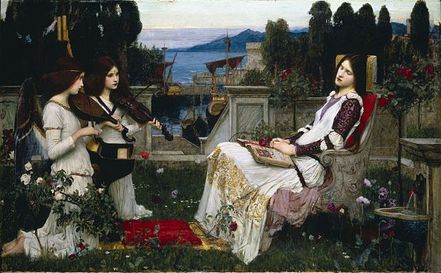|
Why have we programmed Britten’s Hymn to St Cecilia in a concert of Irish and American music? The superficial answer is that Britten wrote it during his journey home to England in 1942, and the ocean is present in both the words and in the gently rocking motion of the music in the first section, bridging the geographical spread of our concert. If we dig a little deeper into the music and the poem, we find that the Hymn to St Cecilia also draws on the ideas of home and of love that run through everything we sing in this programme.
|
Britten had actually begun writing Hymn to St Cecilia while he and his partner, Peter Pears were waiting for exit permits and a place on a ship, but the manuscript was confiscated by customs officials in New York who feared that it contained secret code. Reading the words of Auden’s poem (especially if you’re also thinking about your part in the music and not entirely paying attention), it’s easy to wonder whether that zealous customs officer had a point. The words and music are indeed full of code, but it’s not wartime secrets that it hides, it’s Auden probing analysis of his brilliant young friend, and Britten’s response to it.
St Cecilia was a Roman martyr, and her association with music comes from the legend of her wedding night when she refused to surrender her virginity to her husband, and sat apart at the wedding feast, singing in her heart to God. The immediate connection with Britten, beyond her role as patron saint of music, is that he was born on her feast day, 22 November, but Auden draws out deeper parallels between the two in his poem.
In the first of the three contrasting sections of poem and music, we have a beautiful picture of St Cecilia sitting in her garden by the sea (one legend places her martyrdom in Sicily), the pure, virgin martyr whose music enchants the sensual goddess of love Aphrodite, brings angels down to earth and eases the pain of sinners in hell. Auden would have known of Britten’s great love for the sea, particularly the Suffolk coast, but at this point, in 1942 with Britten’s life in Aldeburgh, and the great sea-themed operas still to come, this vision of the great musician sitting by the sea, pouring forth song, feels almost prophetic.
Britten and Auden could have stopped here to leave a short anthem, just about suitable for church use, using St Cecilia to celebrate the gift of music as a means to praise God, but the poem goes further, turning now to Britten himself, and becoming the song of a precious, slightly irritating child who doesn’t want to grow up. The divided sopranos and tenors chase each other playfully through a teasing, elusive dance, whilst the altos and basses, the boring, responsible adults, hold everything together with their drawn out version of the tune.
Just before Britten left America, Auden sent him a letter that was both loving and stern, urging him to embrace the chaotic, disordered and ugly side of life instead of taking refuge in bourgeois comfort. “Wherever you go”, wrote Auden, “you are and probably always will be surrounded by people who adore you, nurse you, and praise everything you do ….You are always tempted to make things too easy for yourself… to build yourself a warm nest of love … by playing the lovable, talented little boy”. This is the Britten we see in Part Two of Hymn to St Cecilia.
Auden suggested in his letter that Britten needed to suffer, and to accept that he would cause pain to other people too, in order to achieve his full stature as an artist. Britten himself battled against this rather tired cliché, always preferring the comforts and conventions of a post-war middle class lifestyle over Bohemian chaos, but despite his efforts, the ideas of corrupted innocence and the difficulties of the outsider never left him, and bubble up continuously in his music.
The final section of the Hymn to St Cecilia pulls all of this together in a remarkable synthesis, Britten’s music and Auden’s text competing with each other in their audacious beauty. The music is restless, probing, driven onward by the relentless pounding of a falling scale in the bass. The playful boy of part two returns, but now sadder and full of regret, foreshadowing all the lost, broken children who haunt Britten’s operas. Soloists and choir mimic different instruments, but each one – violin, flute and trumpet – links beauty in music to pain and sin before a final heroic solo, a tenor, of course, proudly claims suffering as the artist’s badge of honour: “Oh wear your tribulation like a rose”. This is the final line of Auden’s poem, but Britten returns once more to the refrain, ending his hymn by invoking the virgin saint once more, pleading for pure, artistic inspiration without all that messy, complicated business of human suffering:
Blessed Cecilia, appear in visions
To all musicians, appear and inspire
Translated Daughter, come down and startle
Composing mortals with immortal fire.

